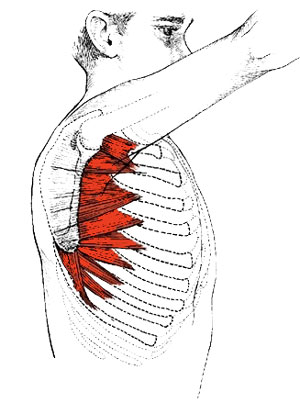The serratus anterior is a key muscle involved with the performance of many overhead movements such as throwing a baseball, serving in tennis, and pressing a barbell overhead. This muscle spans from the upper 8 ribs along the side of the trunk up to the inner border of the shoulder blade. This muscle assists with rotating the shoulder blade (scapula) upwards and tilting it backward in order to position the arm for optimal overhead function. Along with thoracic spine extension mobility, these scapular movements are often ignored as important components of overhead function. The serratus anterior is also the primary muscle that protracts the scapula during upper extremity function. This involves the scapula moving forward along the rib cage such as when punching in boxing.
The Serratus Anterior and Overhead Function in Athletes
Individuals with shoulder problems demonstrate decreased upward rotation of the scapula, decreased posterior tilt of the scapula, and increased activity of the upper trapezius muscle. In particular, swimmers and baseball pitchers commonly present with a pattern of decreased serratus anterior activation and increased activation of the upper trapezius. This alteration in muscle patterns leads to compensatory movements, decreased overhead range of motion, and increased stress to other structures such as the rotator cuff and elbow joint.

Exercises that combine scapular upward rotation, posterior tilt and protraction are ideal to activate the serratus anterior. It is also helpful to include closed chain exercises where the hand is fixed to a surface through the floor or a wall. Finally, exercises performed with the arm elevated above the shoulder or eye level elicit greater activation of the serratus compared to exercises performed at or below the shoulder level. Wall slide and bear crawl variations fulfill these criteria which are optimal to train the serratus anterior in overhead function.
Wall Slide with Foam Roll
Begin with your forearms resting on a foam roll against the wall placed at shoulder height. Protract the shoulder blades by pushing the upper back away from the wall to activate the serratus anterior. Next, “roll” the forearms up the wall in a controlled manner, making sure you don’t lose protraction. Return back to the starting point in a controlled manner and repeat for the desired number of repetitions.
Serratus Anterior Wall Walks with Band
Begin by wrapping a resistance band around your wrists and pulling your wrists apart. Your forearms should remain parallel and take the form of the number “11” throughout the exercise. Protract the shoulder blades by pushing the upper back away from the wall to activate the serratus anterior. Then, “walk” the forearms up the wall in a controlled manner to approximately eye level or slightly higher, making sure you don’t lose protraction. Return back to the starting point in a controlled manner and repeat for the desired number of repetitions.
Bear Crawl
Assume an all-4’s position with the hands in front, shoulder-width apart, feet behind the hips and up in the air. The knees should remain elevated from the floor so you are stabilized by 4 points of contact. Begin by pushing the back up towards the sky to protract the scapula and activate the serratus anterior. Crawl forward starting with your right hand and your left foot following with the left hand and the right foot. After each step, pause briefly to exhale. Take four steps or more depending on space, then turn around and bear crawl back.
Closing Thoughts on Serratus Anterior Exercise
Building a foundation of strength targeting the scapular muscles is crucial for overhead athletes. This foundation should include movements that facilitate activation of the serratus anterior through scapular upward rotation, posterior tilt, and protraction. These exercises can be included as part of a strength training session warm-up or part of a regular arm care program. Overhead athletes, such as baseball players and swimmers, should particularly include exercises targeting the serratus anterior and lower trapezius as part of their year-round strength and conditioning program.


